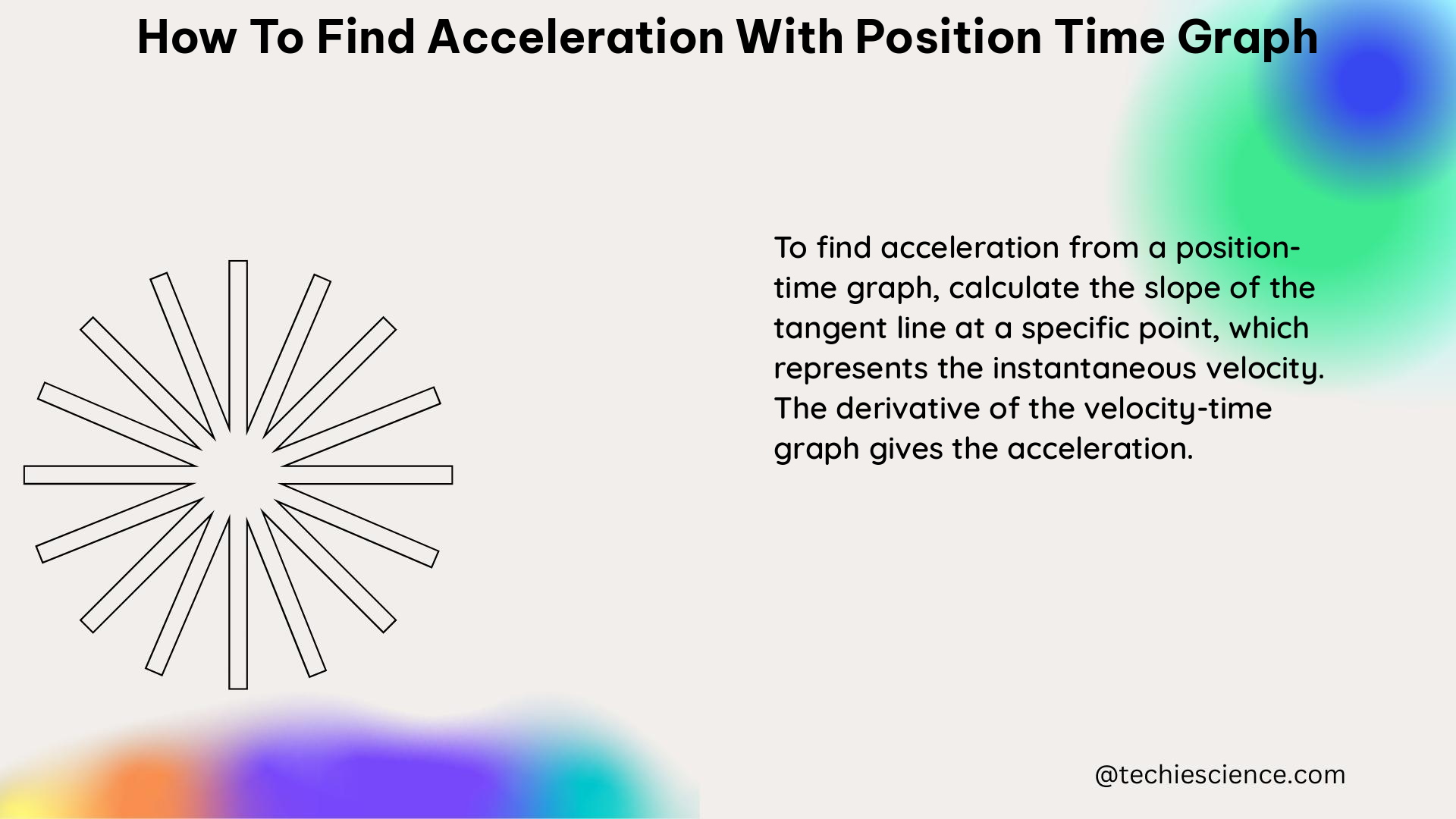Summary
To find acceleration from a position-time graph, you can use the slope of the tangent line at a specific point on the graph. The slope of the tangent line represents the velocity at that point, and the slope of the velocity-time graph at that point represents the acceleration. This method is based on the fundamental principles of kinematics, where acceleration is the derivative of velocity with respect to time, and velocity is the derivative of position with respect to time.
Understanding the Relationship between Position, Velocity, and Acceleration

In kinematics, the relationship between position (s), velocity (v), and acceleration (a) is described by the following equations:
- Velocity is the derivative of position with respect to time:
v = ds/dt - Acceleration is the derivative of velocity with respect to time:
a = dv/dt
or, by the chain rule:
a = d²s/dt²
These relationships form the basis for finding acceleration from a position-time graph.
Finding Acceleration from a Position-Time Graph
To find the acceleration at a specific point on a position-time graph, follow these steps:
-
Identify the point of interest: Determine the time (t) at which you want to find the acceleration.
-
Find the slope of the tangent line: Draw a tangent line that just touches the position-time curve at the point of interest. The slope of this tangent line represents the velocity (v) at that point.
The slope of the tangent line is given by:
v = Δs/Δt
where Δs is the change in position and Δt is the change in time.
- Find the slope of the velocity-time graph: Now, draw a tangent line to the velocity-time graph at the same point of interest. The slope of this tangent line represents the acceleration (a) at that point.
The slope of the velocity-time graph is given by:
a = Δv/Δt
where Δv is the change in velocity and Δt is the change in time.
It’s important to note that this method works only when the acceleration is constant or can be approximated as constant over the small time interval. If the acceleration is changing, you will need to use calculus to find the acceleration at a specific point in time.
Examples
Let’s consider two examples to illustrate the process of finding acceleration from a position-time graph.
Example 1: Constant Acceleration
Suppose the position of an object moving in a straight line is given by the equation:
s(t) = t^2
where s is the position (in meters) and t is the time (in seconds).
To find the acceleration at t = 2 seconds:
-
Find the velocity at t = 2 seconds:
v = ds/dt = 2t = 2 × 2 = 4 m/s -
Find the acceleration at t = 2 seconds:
a = dv/dt = d(2t)/dt = 2 m/s^2
Therefore, the acceleration at t = 2 seconds is 2 m/s^2.
Example 2: Varying Acceleration
Now, let’s consider the position of an object moving in a straight line given by the equation:
s(t) = t^3
where s is the position (in meters) and t is the time (in seconds).
To find the acceleration at t = 2 seconds:
-
Find the velocity at t = 2 seconds:
v = ds/dt = 3t^2 = 3 × 2^2 = 12 m/s -
Find the acceleration at t = 2 seconds:
a = dv/dt = d(3t^2)/dt = 6t = 6 × 2 = 12 m/s^2
Therefore, the acceleration at t = 2 seconds is 12 m/s^2.
Additional Considerations
- If the position-time graph is not given by a simple equation, you can still find the acceleration by following the same steps:
- Find the slope of the tangent line to determine the velocity at the point of interest.
-
Find the slope of the tangent line to the velocity-time graph at the same point to determine the acceleration.
-
When the acceleration is not constant, the slope of the tangent line to the velocity-time graph will change at different points. In such cases, you will need to use calculus to find the acceleration at a specific point in time.
-
Graphical analysis can be a powerful tool for understanding the relationships between position, velocity, and acceleration, but it is important to be aware of its limitations and the assumptions made in the analysis.
Reference Links
- Position/Velocity/Acceleration Part 2: Graphical Analysis – YouTube
- Acceleration on a Position vs Time Graph – YouTube
- Quantitative Position and Time Graphs – YouTube

The lambdageeks.com Core SME Team is a group of experienced subject matter experts from diverse scientific and technical fields including Physics, Chemistry, Technology,Electronics & Electrical Engineering, Automotive, Mechanical Engineering. Our team collaborates to create high-quality, well-researched articles on a wide range of science and technology topics for the lambdageeks.com website.
All Our Senior SME are having more than 7 Years of experience in the respective fields . They are either Working Industry Professionals or assocaited With different Universities. Refer Our Authors Page to get to know About our Core SMEs.